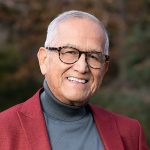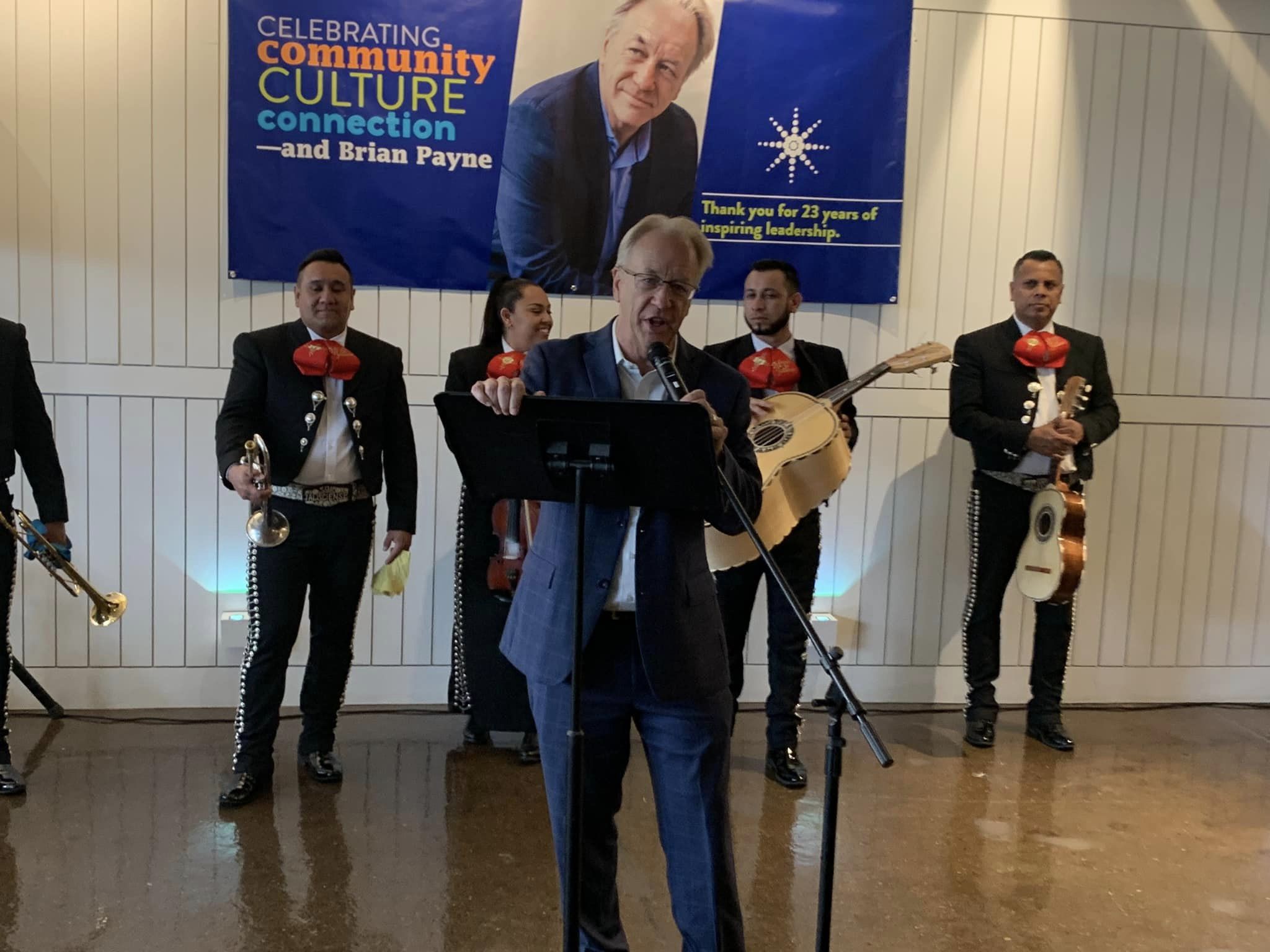
Bran Payne – Courtesy of Tom Alvarez
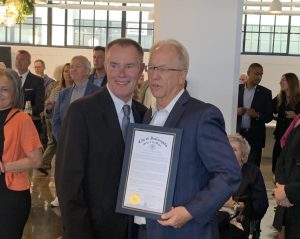
L-R Mayor Joe Hogsett & Brian Payne – Photo by Tom Alvarez
The VisionLoft at the Stutz Building downtown was packed to the gills Tuesday, June 27, with those gathered to honor and pay tribute to Bryan Payne, who was retiring as President & CEO of the Central Indiana Community Foundation (CICF) after 23 years. His last day was Friday, June 30. The atmosphere was truly electric at the sparkling event, which featured a buffet of Latino, Mediterranean and Middle Eastern food, a Mariachi band, and a diverse and inclusive crowd of over 700 hundred guests in attendance—all mirroring the spirit of the CICF mission that includes creating equity for the marginalized in central Indiana.
CICF is an umbrella organization that includes the Indianapolis Foundation and multiple foundations and charitable funds that award grants of $100 million every year to help not-for-profit organizations in central Indiana. Over the years, during Payne’s tenure, the total assets of CICF have grown from $338 million to more than $1 billion. Payne, who is highly regarded as one the most respected and influential not-for-profit leaders in the city, is also celebrated as the visionary and creative force behind the $63 million Indianapolis Cultural Trail that traverses downtown, links its six neighborhood cultural districts, and is a huge impetus for economic development along its path. Payne further reinforced his reputation as a change maker in 2018, when CICF officially updated its mission to support racial equity and inclusion and to dismantle institutional racism in central Indiana.
Reaching out for his perspective regarding Payne’s effectiveness as a leader, I contacted another highly respected community leader, and friend to Payne, philanthropist and arts patron Frank Basile, who said in an email, “Brian is a true visionary with a heart who accomplishes goals through his leadership and passion. Two of his many great initiatives were so compelling to me that I became personally involved at some level – the Cultural Trail and the new mission of CICF and its collectives to dismantle structural and systemic racism. Though he has done so much to positively impact our community, I believe these two will become his legacy. At least so far. I am excited to see what is next!”
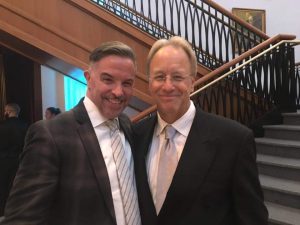
L-R ER==Rob MacPherson & Brian Payne. Courtesy of CICF. Used with permission.
And who knows Payne professionally better than Rob MacPherson? Also, a longtime friend and confidant of Payne’s, MacPherson first worked under him when he was the Director of Development at the Indiana Repertory Theatre from 1994-2001 and then as CICF Vice President for Development and Strategy from January 2003-December 2022 and at the Indianapolis Foundation from January 2023 to the present. Eager to share his thoughts, MacPherson immediately responded by email when I contacted him. When asked about Payne’s impact on the quality of life in central Indiana MacPherson said, “At the level of 30,000 feet, Brian’s legacy will be two significant issues that have had a big impact on our community and will continue to shape our city for generations to come. One is our region embracing and building the concept of a creative economy, or put another way, cultural economic development. The other is having a vulnerable and inclusive conversation about race and racism – and being willing to seek the truth and working to dismantle systemic and structural racism. These two issues are interconnected in his mind and his work because they both involve the discovery, support, and valuing of every single person’s ‘superpower’ (we ALL have them) and what they can contribute to our city and to society in general. Brian’s passions have instilled these values in me and many others across Indianapolis, and we will carry them on in honor of his love for this city.”
Of course, I had to know from MacPherson what it was like to work alongside the dynamo that Payne is all these years. MacPherson extolled, “He is all about working hard, dreaming big and having fun. Authenticity exudes from him. He’s inspiring because he doesn’t get defeated easily and loves to creatively approach work and new ideas. He’s given me incredible latitude over our 28 years together, but our partnership was incredible. He has taught me to live and work through my values and encouraged me to stretch into places I didn’t know I could go. He also is the champion of us getting proximate to the people and the issues we’re learning about and trying to help. Being in real relationship with community is something he insists on and has forever changed the way I approach my life and work.”
I met Payne shortly after he began his tenure at IRT and over the years have enjoyed a casual friendship. He has always been supportive of my work as an arts journalist and Magic Thread Cabaret, a company co-founded by my collaborator, Dustin Klein and me. Over the years Payne and I have shared breakfast on occasion at Café Patachou, at 49th and Pennsylvania, which is a “satellite office” for meetings because it is near his home. One thing I learned while dining with him and during the following interview held with him at Coat Check Coffee House downtown at the Athenaeum: always expect that someone who knows Payne is going to stop by to greet him and he always responds affably. Herein is an edited transcript of my wide-ranging conversation with Payne about his legacy and his future.
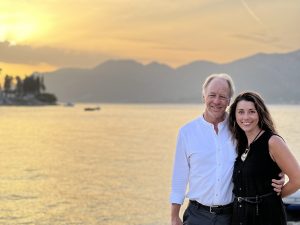
L-R Brian & Gail Payne – Courtesy of Brian Payne. Used with permission.
Do you ever ponder the enormity of the Cultural Trail and your role in it?
Not every day (laughs) but occasionally. There were a few times. One of the most memorable was in 2013 when it was the 10th anniversary of completion of the first eight miles. My wife Gail and Mindy Taylor Ross produced a wonderful festival on May 18 that year. That year I organized a trip with all my partners: David Osborne, the designer; the DPW engineers that we worked with; Mindy; and my wife Gail, whom I fell in love with working on the Trail. Then about three years ago, Gail and I had dinner on Mass Ave, and we were walking to my car at the English Foundation Building. It was a beautiful night; the weather was perfect, and we were looking at the Indy skyline while standing on the Cultural Trail. We both experienced a “Wow” moment realizing that the Cultural Trail had fulfilled every promise we made about it and even some we had not.
As far as the present, seven team members, including spouses, and Gail and me are going to do a six-day hike and bike through Glacier National Park in late August, to celebrate the 10th anniversary of the Cultural Trail’s eight-mile completion.
Are there still those from around the world who visit the Cultural Trail and wish to replicate it?
As a matter of fact, in April, 50 civic leaders and developers from Denver spent a few days studying the Cultural Trail. Denver wants to replicate it. It is way more expensive to build it now than when we built the first leg from 2007 through 2012. I wish them luck.
Has anyone successfully replicated the Cultural Trail?
No one else has come close to connecting a trail to every significant cultural heritage, sports and entertainment venue or destination than Indianapolis. It also connects to six or seven cultural districts. It is also a downtown hub for a Greenway masterplan of Marion County. No one can say that they have done what we have.
Is there evidence that the Trail has changed our culture as far as getting folks to leave their couches?
Yes, certainly there is anecdotal evidence that the Cultural Trail is responsible for people walking and running more. Cultural Trail Inc. does an amazing job of snow removal during the winter. We hear all the time that the trail is the only place runners can run after snowstorms because snow has not been removed in other places or moved where they normally run.
I have always been impressed with the landscaping. Is it maintained regularly?
It must be replaced occasionally. Some of the trees did not make it. One of the things we learned in the early days of the trail was that salt did kill some species. My favorite parts of the trails are where the landscaping is lush and beautiful.
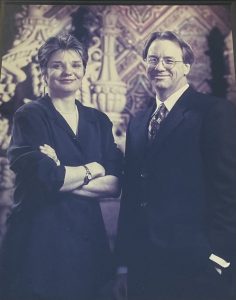
l-R Janet Allen & Brian Payne. Courtesy of Indiana Repertory Theatre. Used with permission.
Let us shift now to the IRT. You came from California to Indy to become IRT’s managing director, didn’t you?
Yes, I ran Santa Cruz Shakespeare and arrived here in 1993.
How do you feel about the contributions you made at IRT?
IRT is incredibly important to me. I have been on the board for nine of the last 10 years. I have two three-year terms. You must take a year off and then get invited back. So now I am in my third year of my three-year term. I think about the two biggest breaks in my career, both taking place in Indy. One is getting a job at IRT. It really gave me a new lease on life because after loving my job in Santa Cruz, but being burned out and having no money and no wealth, I drove across the country from Santa Cruz to Indianapolis to take the IRT job when I was 34-years-old. I had never owned a house, or a new car, and had a net worth of $15,000 in savings bonds. That was all I had. So IRT gave me a chance to build a whole new career, build an adult life, afford to have a child, buy a home like I did nine months later with $15,000. Yes, it changed my life. After seven years, I certainly was not looking to go anywhere, and when I got the job at the CICF, that was another level, and I realized my career could be bigger than I ever imagined.
What was your biggest accomplishment at the IRT?
My predecessor Victoria Nolan did a really good job, with special board leadership and bailing out the IRT from near bankruptcy and closing. She was there for four years and was on a path to sustainability, but that path was not completed when she left to take a big job with Yale Repertory Theatre. But she had put a lot of pieces together. She left in April, and I did not get hired until mid-September and did not start until November. During the interim things fell apart again financially. So when I was hired, I was told everything was great and then by January, I thought, “Oh, my God. We are in big trouble. This could ruin my career. I move to Indianapolis and close the IRT?” I had fears and anxiety about having to take the blame for closing the theatre. Fortunately, we had a great board member, Brent Smith, who was an executive at one of the banks. We convinced a bank to give us a $600,000 line of credit. We did not have a good financial case to get that, and we got it. Then with the help of Jerry Semler, we raised $750,000 emergency dollars from Eli Lilly, from Jerry’s own company, American United Life, where he was CEO, and American States Insurance, and we then had an ability to move ahead. During my tenure, we raised $16 million for a capital and endowment campaign. When I left for CICF, Rob MacPherson led the effort to complete the campaign and make goal. “That campaign renovated the lobby, went from 40 to 70 actors a season, and added $10 million to the endowment. Right now, the IRT is in great shape. Everyone is challenged post Covid. Everyone lost audiences. People have gotten out of the habit of coming downtown and going to the theatre. Everyone is struggling in the American regional theater system, but the IRT has a 27-million-dollar endowment, and that makes them more solid than most.
Any disappointments while there?
My disappointment was that we would do incredible work and the community would not turn out for it enough. Berkeley Repertory Theatre, near where my parents lived, would do a play that was good, and they would sell out every performance. We would do the same play better, and we would have 40% houses. That would break my heart. In the decade I spent at IRT, I thought, “I love Indianapolis, but it is one of the worst cities to run an arts organization in as far as feeling that your work matters.”
You did not realize Indianapolis was culturally disadvantaged at the time?
No, I did not. When I got to the IRT the artistic process was as important as the artistic output. I really feel that artists must be respected in the artistic process. There is this narrative or this reputation that American Conservatory Theatre in San Francisco, the dominant professional theatre on the whole West Coast at the time, had. William Ball, the founder, was a legend. He was the artistic director. The narrative about the ACT was that they only cared about the actors. If you were staff, you were shit. If you were a designer, they really did not care about you either. It was an actor-based troupe, and they only cared about actors. Do you know what? We respected everybody at the IRT. That preexisted me. I loved that, and I helped enhance that, which I am very proud of. Janet (Allen) was a huge enhancer of that before I got there and after I left. And Libby (Appel) cared about that, too, so that was in the DNA before I got there, but I really honored it.

Brian Payne – Courtesy of CICF. Used with permission.
Moving on to CICF, what has been your biggest accomplishment?
CICF, with my leadership and huge collegial board support, we created a conversation about race and racism that had not existed in decades. We put racism on the table and named systemic racism for central Indiana. We said if we were going to thrive and if we were going to be a community where every individual is going to have an equitable opportunity, we have to deal with racism and systemic racism. We must learn what this is and how that works. I was not here and did not move here until 93, but I never heard a conversation about race in my entire time until we put a civic conversation on the table in 2018, and I am very proud about that. I am proud that we have shone the light on how to move forward with that work. Now there is a huge backlash in the state legislature that is racist and anti LGTBQIA+. I am really looking forward to the Pride Parade and hope there is even a bigger turn out than normal that says, “Fuck you to the legislature.” Yes, I can I say that. Yes, “Fuck you,” to the legislature. I am sure there were conversations in the 60s. I hope.
As far as the Cultural Trail is concerned, it started out as a hobby of mine because we did not do that kind of work at the foundation. We a at CICF weren’t supposed to have ideas. We are supposed to grant other people’s ideas. And I thought, “Wait a minute, I am in rooms and at tables where no one else is, and a combination of tables where no one else is.” That creates a lot of energy and a lot of cross sector ideas, and I thought, “Why not? Why can’t we have ideas? We are in a better position to have ideas than most.” We should be an entrepreneurial organization, so I created that ideal and then the cultural trail modeled that ideal by accident and then we followed that and became a creative, visionary entity. We are in a privileged position to see what can be connected to something new in this city. No one else has the same privileged position we do.
You have changed a lot of hearts and minds through your efforts at CICF, don’t you think?
I broadened the partnership with the board. Not one person can do it alone. The board could have shot me down. They did in the beginning, but I was able to build a supportive one.

Brian Payne – Courtesy of CICF. Used with permission.
How have you reconciled serving as a funder and an arts advocate at the same time?
Luckily, my board has been very supportive of the arts and me being supportive of the arts. The Indianapolis Foundation has supported me into putting a million dollars into resourcing a Black professional actors equity theatre company, which we are trying to build sustainability at The District Theatre. A million dollars for a new upstart theatre company. We are trying to raise money for four seasons before we even start. We want contracts for six actors per show with four shows a year and to run 11 or 12 performances.
Have you taught leadership classes?
I have guest lectured a lot; I am doing some executive coaching. My first couple of clients are executives of community foundations around racial equity internally and externally. My masters are in theatre producing and management from UCLA. It is called theatre producing and managing. I am doing a one-year contract with SPEA (School of Public and Environmental Affairs) at IU in Bloomington, the Paul H. O’Neill School of Public and Environmental Affairs. It has arts administration in that school.
Any more future plans?
I have had June 30, 2023, in mind for five years as my retirement date. For the longest time I did not know what to do, but I knew how often I wanted to do something. At Santa Cruz Shakespeare, I had a lot of 80-hour weeks. At IRT, I had a lot of 70-hour weeks. At CICF I have had mostly 60-hour work weeks, and in the last few years a lot of 50-hour work weeks. As I am older, I am not able to work 60 hours with the same kind of passion and joy, but I want to go from 50-hour work weeks to 50-hour work months. I want to work, but I want flexibility. Gene Temple is a good friend of mine, and he said, “I did not enter ‘retirement,’ I entered ‘preferment.’” So, I am going to do the things I prefer, being in Bloomington working with students, leadership, public policy, and producing. So I am not fully retiring, moving from 50 hours a week to 50 hours a month is going to give me time to pursue other passions.
So, you are becoming a freelancer.
Yes, I am entering the gig economy. How about that? I am going to be a gigger. (laughs) There is this really great book, Tom, called “From Strength to Strength: Finding Success, Happiness and Deep Purpose in the Second Half of Life” by Arthur C. Brooks. This book has had a profound impact on my thinking. It basically says to be truly happy you have to make this leap from the kind of intelligence it takes to work 60 hours a week and drive projects into completion and now as you are older, you should really use your wisdom and be a mentor, be a teacher, or be a coach. Those are the kinds of things we are better suited for in our sixties than trying to hold on to that status of the past.
Any thoughts about passing the torch?
The Indianapolis Foundation part of us has reorganized. I have been the head of the CICF and the Indianapolis Foundation, but we are rebuilding the brand of the Indianapolis Foundation. I felt strongly that this moment in time, a Black person needs to run the Indianapolis Foundation, overseeing community leadership and grant making in Indianapolis, and that is what is happening. Dr. Lorenzo Esters is the new president. He has been the president of Ivy Tech, and I felt that this is the time for me to play a different role as a white guy. There are important roles for white people to play but at this moment in time, the Indianapolis Foundation needs to have a Black person in charge.

Brian Payne – Courtesy of CICF. Used with permission.
Do you think you will experience grief once you leave CICF?
I do not anticipate it. But I know it is possible. I feel so fortunate. When we finished the Cultural Trail 10 years ago, people said, “You are still a young man. You are in your early fifties so the next ten years is when you will have your biggest achievement. Aren’t you worried? You have already done it with the Cultural Trail.” My response was, “Actually, it takes pressure off me. I am thrilled.” Will I do anything bigger than the Cultural Trail? At the time, I said I do not think so. However, I am prouder of what we have done putting race and racism on the table, what we have done to share power with Black and Brown people in this community. That is a much bigger legacy than the Cultural Trail.
CICF was addressing inequality prior to the Black Lives Matter movement bursting onto the scene, wasn’t it?
We are proud that we went public with our focus on equitable opportunity and that our mission is about creating a community where every individual has equitable opportunity no matter race, place, or identity, which for us is sexual identity and gender identity. On the racial part, we went public in 2018. “Indianapolis Business Journal” did a full-page cover story on our new mission July 1, 2018. That was almost two years before George Floyd was murdered. After Floyd’s killing, every not-for-profit scrambled to decide what they were going to do about racial equity, inclusion, and diversity and we were ahead of that by two years. I must give a shout out to Janet and Libby and the IRT. When I got hired in 1993, one of my very first meetings as the new guy was to meet with the African American diversity committee for the IRT, and the IRT every year did at least two Black plays. However, at the time we were not seeing Black actors in non-Black plays.
What will you miss about your job?
My favorite moments are those creative moments in meetings with smart creative people, and everyone is getting excited about something new. I am hoping that does not go away in my life. But I will not have the platform where it naturally happens on a weekly if not a daily basis. When we have a great meeting to find solutions to a problem or how to make the city better or some idea, when you are spending time together with creatives and artists, and everyone is clicking—boy that is magic to me. I will miss that frequent opportunity to have that experience.
Tell me about how you envision your life post CICF.
My wife Gail is an actor in New York City. She has done some singing in New York, but it’s hard to pay the bills with cabaret. She does have two television and film agents. But now there is a writer’s strike. Covid wiped out two of the plays she was cast in. She, like a lot of actors, has not had an easy time of it and the world has not cooperated, but I will be living half time in New York. I am very anonymous there but we have a few friends there. I will be there half the time and half the time here. If you are not here, you cannot be fully participatory so it will be a good balance for me.
Have any concerns about becoming a has been?
I am not anticipating that. I am not going to get my ego hurt that I am not THE guy or one of THE guys. I spend time together with creatives. I love creative people and value creativity, so I wanted people to know that an idea was my idea. That is when my ego went overboard a little bit. The Cultural Trail fed my ego even more than I thought it would ever be fed. I am fine now. (laughs) Ego comes out when you doubt your self-worth, or people are not affirming it for you. But now, I am in a pretty good place. I might be surprised. I might return and have feelings that no one knows anything about me three years from now (laughs).
Are you experiencing numerous farewell coffees and lunches these days?
I am getting a lot of nice affirmation right now, and I appreciate it. There is a big idea I am hoping to pull off, but it is not going to be easy. I do not know how to cook. Cooking is not my superpower. My son says, “Dad you don’t cook; you heat up.” But Rob (MacPherson) is going to teach me how to cook a meal. Joel Grynheim (husband to Janet Allen) is going to teach me one as well. I have four people, in total, who are going to teach me how to cook great meals. I really want to master those meals. I love dinner parties for six. So when my wife is in town it will be me, her, and four other people. I will sit around the table and have a group conversation rather than just to the person to your left or right. I am going to excel at four different meals and have a dinner party once a month. That is one of my top goals.





